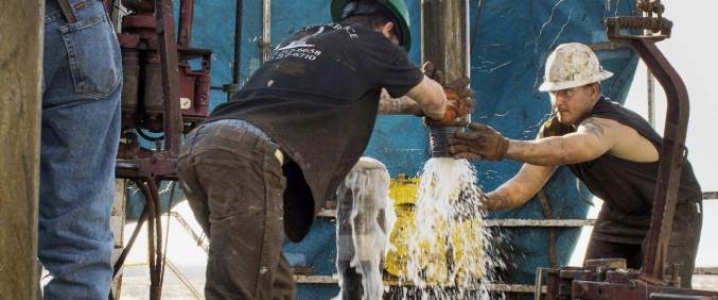The Permian has been getting most of the headlines on U.S. shale, but there is another play in the vicinity that has been attracting more industry attention than media attention. Pretty much forgotten since the ‘90s, when shale oil and gas moved to the forefront of the U.S. oil industry, the Austin Chalk has now gotten a new lease on life, it seems.
Over the last six months, oil majors including ConocoPhillips, Marathon Oil, and EOG Resources have purchased some 600,000 acres in the chalk formation that runs from the Mexico-Texas border through central Louisiana and into Mississippi. Drilling is set to begin in late 2018. And that’s not all, because drillers are also returning to old fields in the Chalk.
Reuters recently reported that an independent player, Wildhorse Resource Development, has started drilling in an old field in the Chalk using technology developed for the shale plays. Though the Chalk is not a shale formation—it is, as the name suggests, made up of limestone and chalk, soaked with oil and gas—and fracking tech could increase resource recovery.
Drillings rigs in the Austin Chalk rose twofold in the past six months, Reuters said, quoting DrillingInfo data, to 14, and production grew to 57,000 bpd in 2017 from just 3,000 bpd five years ago. Technically recoverable oil reserves stand at around 4.1 billion barrels and gas reserves are estimated at 18 trillion cu ft, according to the Energy Information Administration. Related: Iran Warns North Korea About The United States
That’s plenty of oil and gas, and one begins to wonder why we aren’t hearing more about the Austin Chalk. Well, as it happens, the play is not without its problems. In a recent story, Bloomberg’s Alex Nissbaum noted, quoting Wood Mackenzie, that the Chalk has a bad reputation with wells that start strong and then quickly dry up. That’s because of the geology of the place: it is highly fractured, which means the geology changes quickly over short distances, “so you have to do a lot of geology to understand where it’s going to produce," a drilling industry insider told Nissbaum.
Oil and gas production from the Chalk has until now been done using conventional drilling methods. Now, fracking tech is being applied to the formation with drillers seeing long horizontal wells combined with steerable drilling and the injection of sand and chemicals mixtures improving recovery rates.
In fact, thanks to the application of this technology, some test wells in the Chalk are already outperforming shale wells. Wildhorse, for example, says some of its newly drilled wells in the Chalk produced three times more than the initial output from comparable Eagle Ford wells. EOG also said its Austin Chalk wells yielded over two times more than a new well in the Permian.
Then there is the fact of the Chalk’s proximity to the Gulf Coast refiners and the fact that land is still cheap. This combination of factors could bring it into the spotlight to rival the Permian, especially when we throw in the fact that parts of the Chalk are overlapping with the Eagle Ford play, meaning that drillers in these parts could tap the oil and gas from more than one formation. Given all that, we will probably be hearing more about the Chalk in the coming months.
By Irina Slav for Oilprice.com
ADVERTISEMENT
More Top Reads From Oilprice.com:
- Venezuela Won’t Have Enough Oil To Export By 2019
- OPEC Back “In the Driver’s Seat”
- The Bullish And Bearish Case For Oil


















This is a totally erroneous and misleading statement regarding the Austin Chalk Play in South Texas. The Austin Chalk Giddings Field area was aggressively drilled using conventional vertical wells to capture oil in the naturally fractured Austin Chalk Formation during the 1975 to early 1980's time period.
Next in the 1988 to 1995 era the Austin Chalk Giddings Field area was the 'birth-place' for Horizontal Drilling activity and technology advancement with 1,000 Austin Chalk horizontal wells drilled in 1990 alone, and 4,000 horizontal wells drilled from 1990 to 1995 period. This was a true oil boom and birth for Horizontal well drilling.
Downhole steerable drilling was the norm, along with the beginning utilization of multi-stage fracture stimulation. The primary target was the natural fractures in the Austin Chalk utilizing extended horizontal well bores instead of the single vertical well bores used in the 1975-1980's vertical well era. To maximize location of the natural fractures via horizontal drilling, stress & strain geology concepts were utilized along with micro-fracture identification with 2D seismic data. The seismic data was also critical for downhole steering/drilling/navigating in the fractured Austin Chalk Formation.
The latest revitalized Austin Chalk play entails horizontal drilling and modern dense multi-stage fracture stimulation in the geographic areas which were avoided in the 1988-1995 era where natural fractures were minimal or absent.
Early pre-Horizontal Drilling era Austin Chalk vertical wells were hydraulically fractured and proved how advantageous fracture stimulation was. A 1961 Chalk well drilled by Union, produced 36 kbo until 1971. In 1973, after hydraulic stimulation, the vertical well produced 500 kbo by 1981. This proved the merits of hydraulic stimulation in the Austin Chalk Formation.
Regardless, the Austin Chalk era of 1988-1995 marked a true frenzy for Horizontal Drilling where significant advances were developed in drilling, downhole steering, and multi-stage fracture stimulation. This Austin Chalk era marked the birth place for unconventional modern Horizontal Drilling.